Key takeaways:
- Fermentation transforms simple ingredients into complex flavors, requiring patience and experimentation.
- It connects us to culinary traditions and enhances health through probiotics in fermented foods.
- Key ingredients for successful fermentation include fresh produce, salt, clean water, and controlled temperature.
- Creating an ideal fermentation environment and maintaining cleanliness are crucial for success.
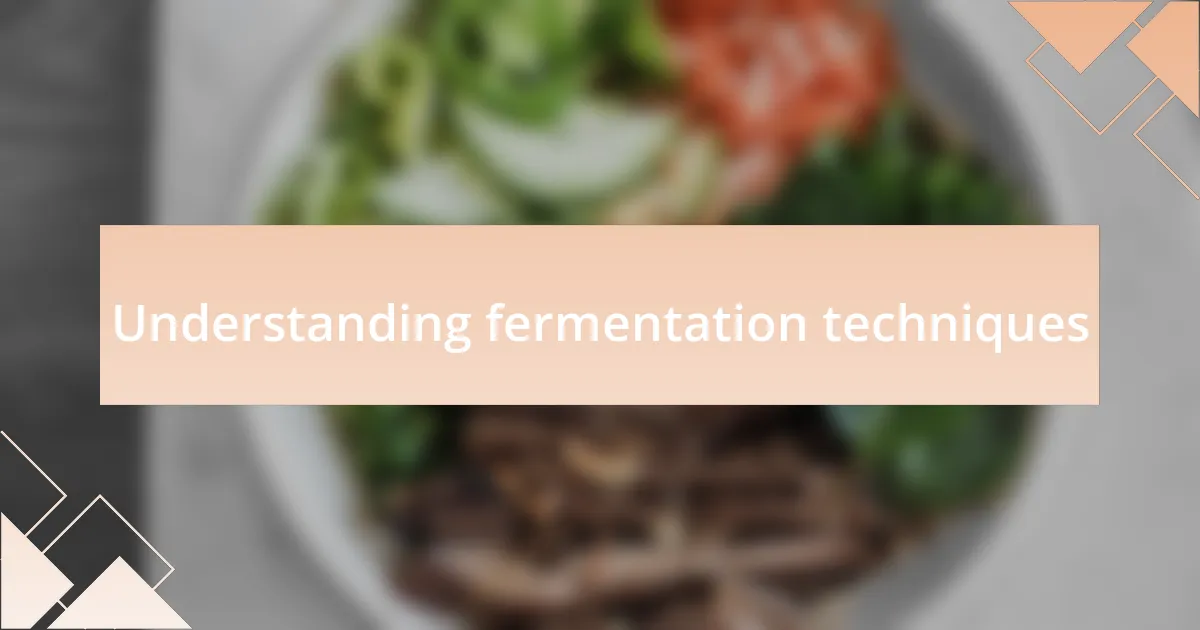
Understanding fermentation techniques
Fermentation is a fascinating process that transforms simple ingredients into complex flavors and textures. I remember the first time I tried making sauerkraut at home. The anticipation of tasting my creation after a week of waiting taught me just how important patience is in fermentation.
Understanding fermentation techniques involves more than just waiting for food to ferment; it’s like nurturing a living organism. I often find myself marveling at the diversity of fermented products, from tangy yogurt to zesty kimchi. Have you ever wondered how these distinct flavors develop? It’s all thanks to the microorganisms involved, each contributing its unique characteristics.
The beauty of fermentation lies in its combination of science and art. When I experimented with making my own kombucha, the delicate balance of temperature, time, and sweetness became evident. It was a dance of trial and error; the excitement of each brew taught me that fermentation is as much about experimenting and discovering as it is about following methods. How do you think your palate might shift after trying your hand at fermentation?
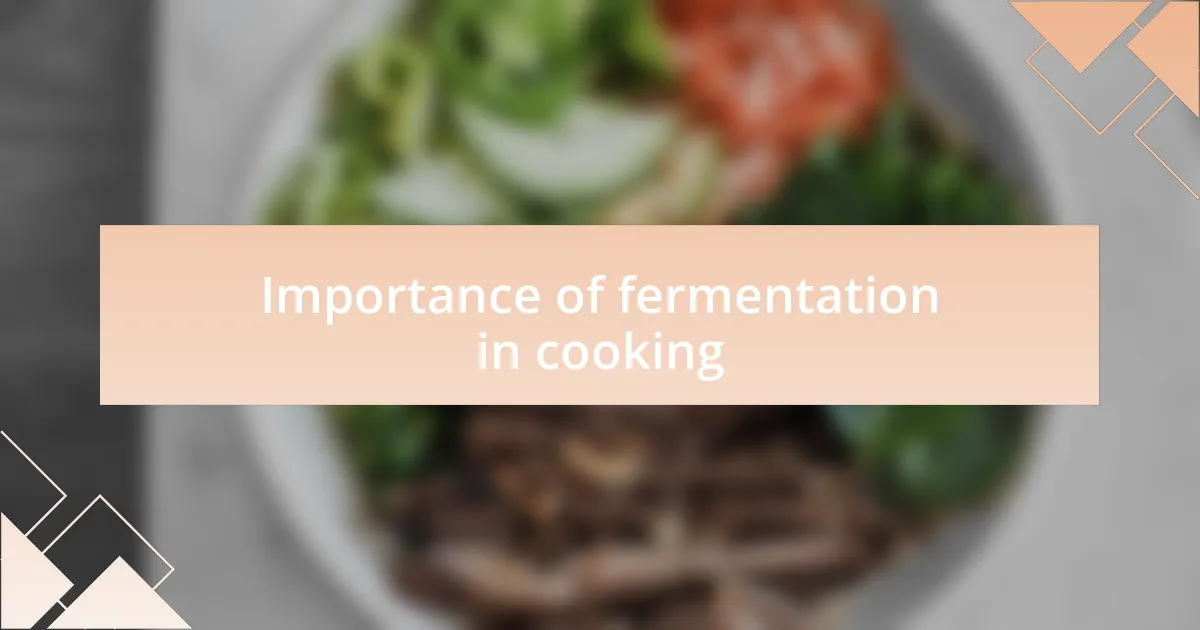
Importance of fermentation in cooking
Fermentation plays a crucial role in enriching the culinary landscape. I vividly recall the first time I tasted handmade yogurt; the tanginess was a revelation compared to store-bought varieties. That experience made me realize that fermentation doesn’t just enhance flavors; it also connects us to traditions and cultures around the world, breathing life into our meals.
The health benefits of fermentation cannot be overlooked either. When I incorporated more fermented foods into my diet, I noticed a significant boost in my digestion and energy levels. Have you considered how probiotics, the beneficial bacteria in fermented foods, can positively impact your gut health? It’s fascinating to think about the invisible but powerful influence these tiny organisms have on our well-being.
Moreover, fermentation allows for creative expression in the kitchen. I’ve experimented with fermenting fruits like mangoes into chutneys, which opened up a new world of flavor combinations. Isn’t it amazing how a simple process can take everyday ingredients and elevate them to something extraordinary? Each batch adds a personal touch to my meals and serves as a reminder of the beautiful relationship between food and creativity.
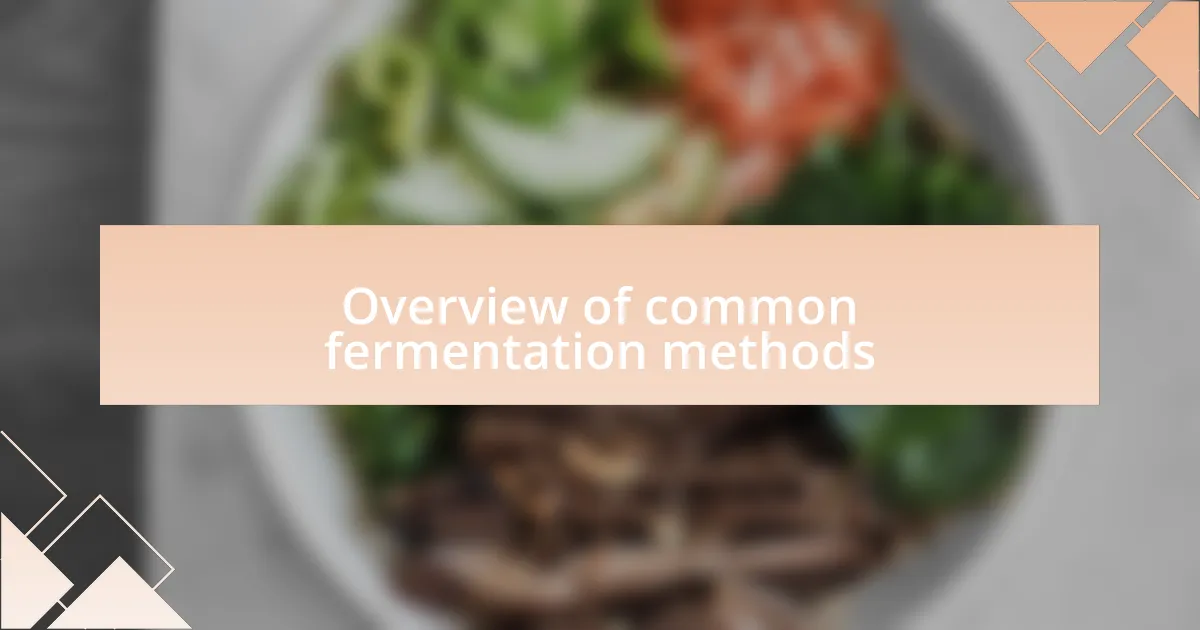
Overview of common fermentation methods
Fermentation techniques vary widely, with each method bringing its unique flair to the culinary world. For instance, I remember my first venture into the world of sauerkraut. The combination of cabbage, salt, and the fermentation process transformed those simple ingredients into a tangy, crunchy delight that was far more complex in flavor than I ever expected. Isn’t it interesting how just a few ingredients can create something so vibrant and profound?
Another method I found fascinating is lacto-fermentation, particularly when I experimented with pickling. The delightful zing of pickled radishes caught me off guard; the process not only preserved them but also amplified their natural sweetness. It makes me wonder—what other hidden flavors are waiting to be unlocked through fermentation techniques that we haven’t yet explored?
Then there’s alcoholic fermentation, which, while a bit more complex, has its own allure. I recently tried my hand at brewing ginger beer. The sight of those bubbles forming as the yeast worked its magic was mesmerizing. It’s incredible how patience and a little science can yield a refreshing beverage that’s perfect for sharing during gatherings. Have you thought about how these traditions could transform your culinary adventures? Each fermentation technique is a new story, inviting you to experiment and discover.
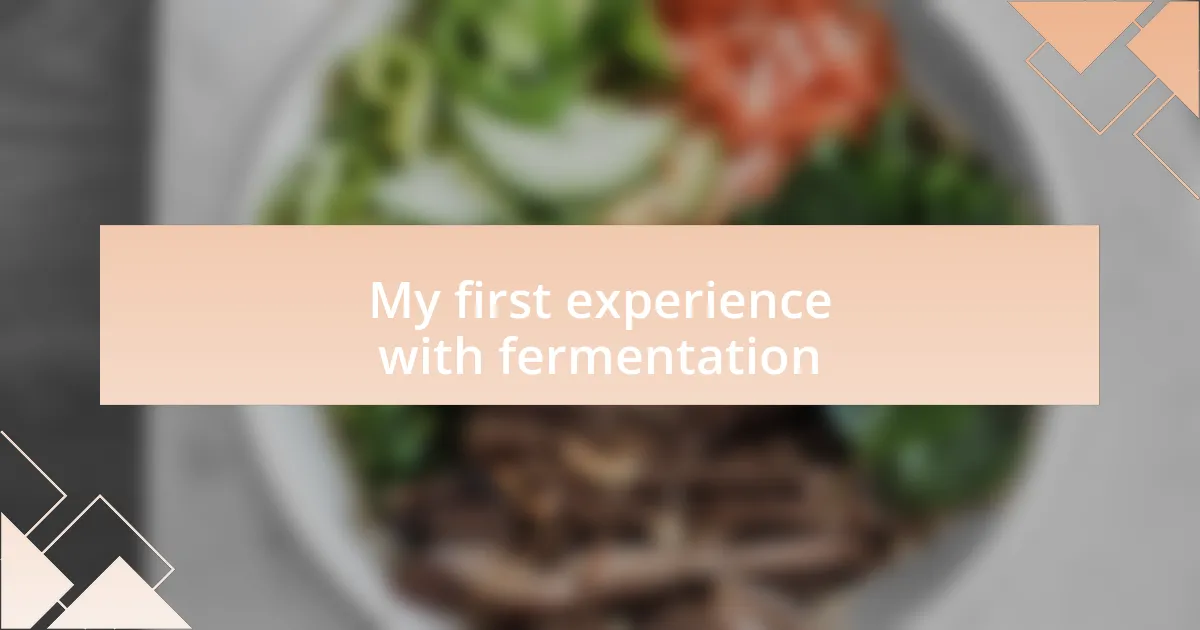
My first experience with fermentation
My first experience with fermentation began in my kitchen, where I stumbled upon a simple recipe for homemade yogurt. At first, I was apprehensive about letting milk sit out overnight with just a few spoonfuls of store-bought yogurt as a starter. However, waking up to find it transformed into creamy, tangy yogurt was nothing short of magical. Could I really create something so delicious from just milk and a little bacteria?
The moment I tasted that first spoonful, I felt a rush of pride and excitement. It was smooth and rich, a symphony of flavors dancing on my palate. I still remember the thrill of thinking, “I made this!” That first batch of yogurt marked a turning point for me; it awakened a curiosity about fermentation that I had never expected. Isn’t it amazing how one simple act of culinary alchemy can ignite such a passion?
From that small, humble beginning, I later ventured into fermenting veggies. I recall a particularly colorful batch of carrots and garlic that transformed into a zesty condiment. The vibrant colors and rich aromas not only brightened my meals but also reminded me of how deeply interconnected food is with culture and heritage. It left me reflecting: isn’t the art of fermentation a bridge that connects us to traditions and flavors from around the world?
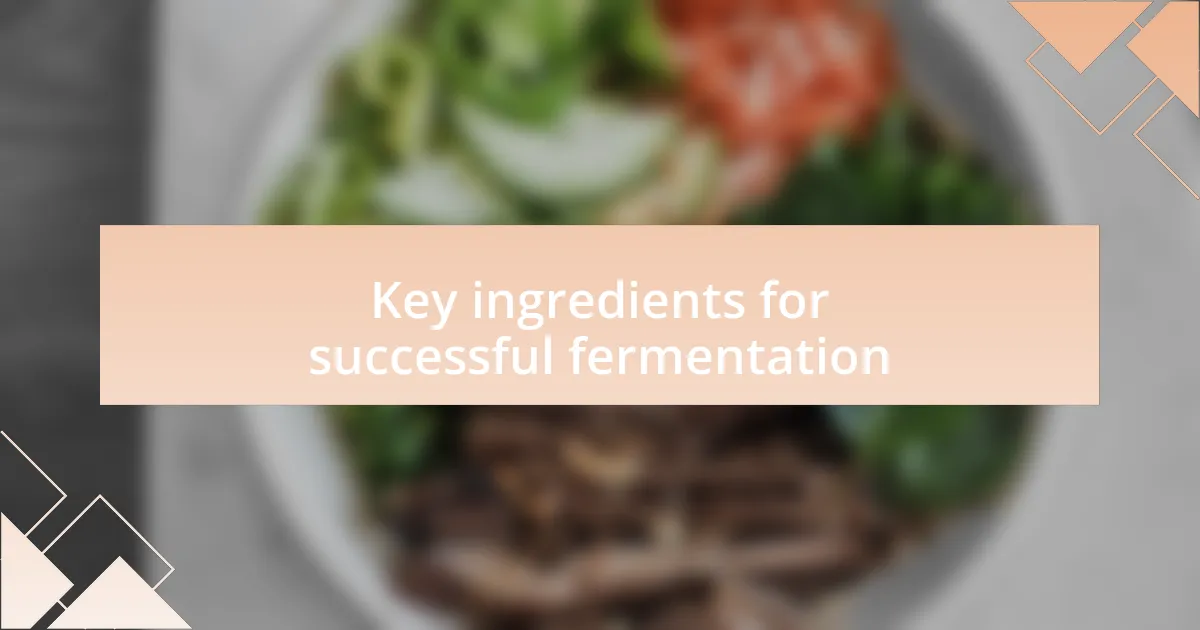
Key ingredients for successful fermentation
When it comes to fermentation, the key ingredients are often simpler than you might think. Take my experience with sauerkraut, for example. The perfect balance of fresh cabbage and pure sea salt creates the ideal environment for lactic acid bacteria to thrive. I still remember how that simple, crisp cabbage was transformed into a tangy condiment that added depth to countless meals. Have you ever marveled at how just two ingredients can yield something so flavorful?
Water plays a crucial role in the fermentation process, particularly in brines. I learned this firsthand while experimenting with dill pickles. Using filtered water instead of tap water made all the difference in the fermentation process. It resulted in a cleaner taste, enhancing the vibrant flavors of fresh cucumbers and spices. Wasn’t it fascinating to see how something as basic as the water’s purity could impact the end result?
Lastly, let’s not forget about temperature, the often-overlooked ingredient in fermentation. I found that my kitchen’s warmth during the summer months accelerated the fermentation of my kimchi, leading to a tangier product much faster than in cooler months. This experience taught me to embrace seasonal variations in my fermentation endeavors; it’s like dancing with nature itself. Have you considered how the environment affects your culinary creations?
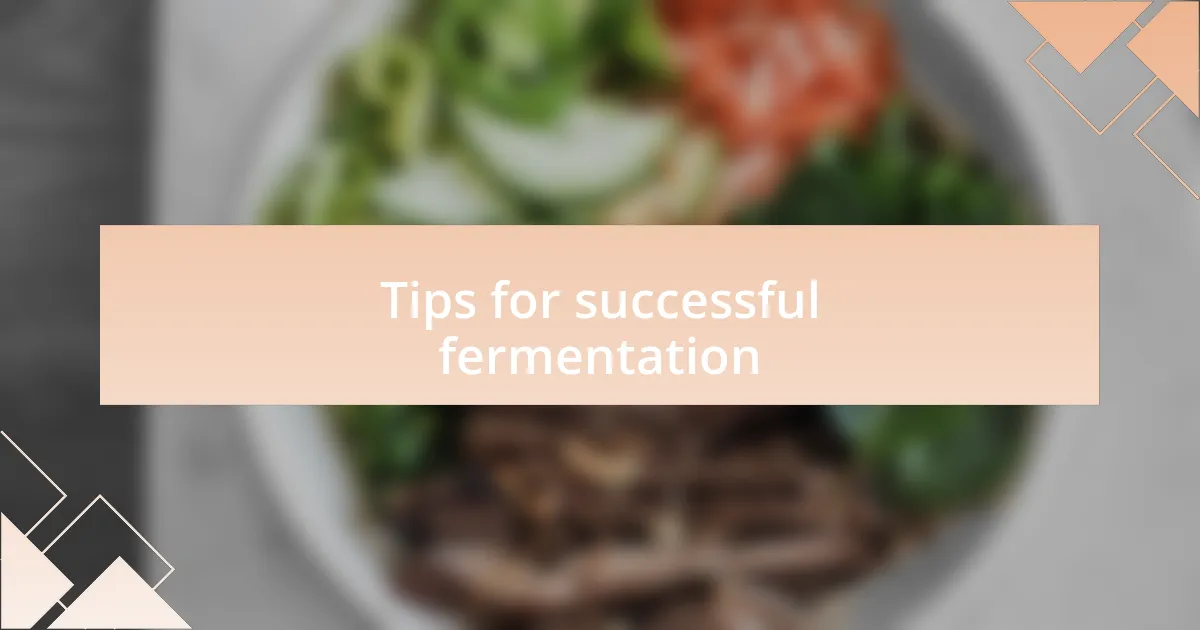
Tips for successful fermentation
Creating an ideal environment for fermentation is essential. I recall a winter batch of beet kvass I made, where the chilly weather led to a sluggish fermentation. It was a challenge, but I learned that wrapping the jar in a warm towel was a simple trick to maintain a consistent temperature. Have you ever tried adjusting your settings to boost your process?
Mindfulness about cleanliness cannot be overstated. I remember a time when I got a bit too casual about sanitation while preparing my first batch of kombucha. The result was a sour mess that I’d rather forget! Now, I make sure to thoroughly clean every surface and ingredient before I dive in. What precautions do you take to ensure a successful fermentation?
Finally, patience is a vital component of fermentation. I used to anxiously check on my sourdough starter every few hours, only to feel disheartened by a lack of bubbles. But once I learned to let it sit undisturbed, giving it space to develop, the transformation was magnificent. Have you ever experienced the thrill of waiting for something delicious to develop? Remember, good things come to those who wait!